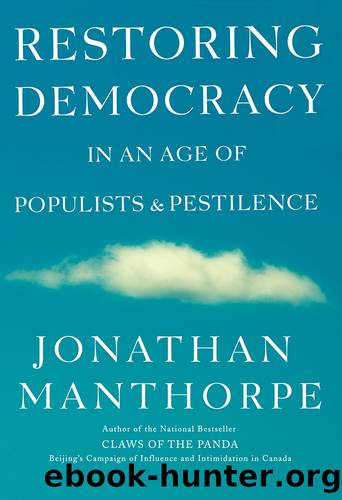Restoring Democracy in an Age of Populists and Pestilence by Jonathan Manthorpe

Author:Jonathan Manthorpe
Language: eng
Format: epub
Tags: Political Science
ISBN: 9781770865839
Publisher: Cormorant Books
Published: 2020-08-29T00:00:00+00:00
CHAPTER NINE
From the Four Basic Principles to the Chinese Dream and the Covid-19 Nightmare
IN THE DAYS after the Tiananmen Square Massacre over the night of June 3â4, 1989, paramount leader Deng Xiaoping proved yet again that it takes a cool head and a firm grip to rule China. Deng and seven other veteran Chinese Communist Party leaders had come out of semi-retirement in May. They took back control after it became obvious that the new generation of frontline party leaders did not know how to respond to the hundreds of thousands of students camped out in Beijingâs Tiananmen Square, demanding political reform. As the protests spread to up to one hundred other cities across China, the elders decided that any concessions to the students would plunge the country into anarchy and that it was time for a firm response. At a meeting on May 17 with the partyâs Standing Committee, the hub of power, Deng proposed that martial law be declared. After some strenuous debate, the committee agreed. The following day, May 18, all eight elders met with the Central Military Commission, of which Deng was still the chairman, to solidify the consensus and make sure the Peopleâs Liberation Army (PLA) would remain loyal to the CCP even when ordered to kill Chinese people. In the early hours of May 20, Premier Li Peng signed the order for martial law, which came into force that same morning. The order made the studentsâ demonstrations illegal and gave the PLA the authority âto use all necessary means, including force, to deal with prohibited activities.â Over the following weeks, the party leaders convinced themselves that the students were actually a counter-revolutionary uprising sponsored by foreign powers. The troops enforcing martial law were indoctrinated with the same message. As the leaders worked themselves into a passion, there were signs of protest fatigue and demoralization among the students in the square and a drop in the number of similar demonstrations in cities around the country. It seemed the right moment to strike. The troops moved in on the night of June 3 and the early hours of June 4.
According to the official account prepared afterwards, âFive thousand PLA soldiers and officers [were] wounded, and more than two thousand local people (counting students, city people, and rioters together) also wounded.â The report declared, âThe figures on the dead are these: twenty-three from the martial law troops, including ten from the PLA and thirteen from the Peopleâs Armed Police. About 200 soldiers are also missing. The dead among the city people, students, and rioters number about two hundred, of whom thirty-six are university students. No one was killed within Tiananmen Square itself.â
The CCP and Chinese officials have stuck firmly to those numbers in the three decades since. Other estimates, including those from eyewitnesses, are much higher and conclude that more than one thousand people were killed in and around the square. One of the highest numbers came from the UKâs ambassador to Beijing, Sir Alan Donald, who
Download
This site does not store any files on its server. We only index and link to content provided by other sites. Please contact the content providers to delete copyright contents if any and email us, we'll remove relevant links or contents immediately.
The Secret History by Donna Tartt(16762)
The Social Justice Warrior Handbook by Lisa De Pasquale(11517)
Thirteen Reasons Why by Jay Asher(7857)
This Is How You Lose Her by Junot Diaz(5845)
Weapons of Math Destruction by Cathy O'Neil(5094)
Zero to One by Peter Thiel(4885)
The Myth of the Strong Leader by Archie Brown(4821)
Promise Me, Dad by Joe Biden(4494)
Beartown by Fredrik Backman(4489)
How Democracies Die by Steven Levitsky & Daniel Ziblatt(4466)
Stone's Rules by Roger Stone(4455)
The Fire Next Time by James Baldwin(4398)
100 Deadly Skills by Clint Emerson(4128)
A Higher Loyalty: Truth, Lies, and Leadership by James Comey(4073)
Rise and Kill First by Ronen Bergman(4063)
The David Icke Guide to the Global Conspiracy (and how to end it) by David Icke(3935)
The Farm by Tom Rob Smith(3909)
Secrecy World by Jake Bernstein(3828)
The Doomsday Machine by Daniel Ellsberg(3772)
